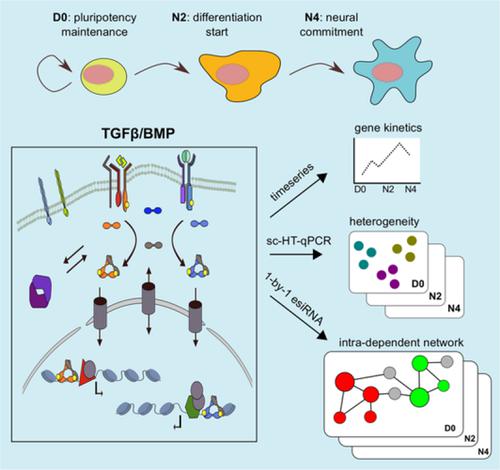当前位置:
X-MOL 学术
›
STEM CELLS
›
论文详情
Our official English website, www.x-mol.net, welcomes your feedback! (Note: you will need to create a separate account there.)
Integrative and perturbation based analysis of the transcriptional dynamics of TGFβ/BMP system components in transition from embryonic stem cells to neural progenitors
STEM CELLS ( IF 5.2 ) Pub Date : 2019-12-13 , DOI: 10.1002/stem.3111 Ruben Dries 1, 2 , Agata Stryjewska 2 , Kathleen Coddens 2 , Satoshi Okawa 3, 4 , Tineke Notelaers 2 , Judith Birkhoff 1 , Mike Dekker 1 , Catherine M. Verfaillie 2 , Antonio del Sol 3, 5, 6 , Eskeatnaf Mulugeta 1 , Andrea Conidi 1, 2 , Frank G. Grosveld 1 , Danny Huylebroeck 1, 2
STEM CELLS ( IF 5.2 ) Pub Date : 2019-12-13 , DOI: 10.1002/stem.3111 Ruben Dries 1, 2 , Agata Stryjewska 2 , Kathleen Coddens 2 , Satoshi Okawa 3, 4 , Tineke Notelaers 2 , Judith Birkhoff 1 , Mike Dekker 1 , Catherine M. Verfaillie 2 , Antonio del Sol 3, 5, 6 , Eskeatnaf Mulugeta 1 , Andrea Conidi 1, 2 , Frank G. Grosveld 1 , Danny Huylebroeck 1, 2
Affiliation

|
Cooperative actions of extrinsic signals and cell‐intrinsic transcription factors alter gene regulatory networks enabling cells to respond appropriately to environmental cues. Signaling by transforming growth factor type β (TGFβ) family ligands (eg, bone morphogenetic proteins [BMPs] and Activin/Nodal) exerts cell‐type specific and context‐dependent transcriptional changes, thereby steering cellular transitions throughout embryogenesis. Little is known about coordinated regulation and transcriptional interplay of the TGFβ system. To understand intrafamily transcriptional regulation as part of this system's actions during development, we selected 95 of its components and investigated their mRNA‐expression dynamics, gene‐gene interactions, and single‐cell expression heterogeneity in mouse embryonic stem cells transiting to neural progenitors. Interrogation at 24 hour intervals identified four types of temporal gene transcription profiles that capture all stages, that is, pluripotency, epiblast formation, and neural commitment. Then, between each stage we performed esiRNA‐based perturbation of each individual component and documented the effect on steady‐state mRNA levels of the remaining 94 components. This exposed an intricate system of multilevel regulation whereby the majority of gene‐gene interactions display a marked cell‐stage specific behavior. Furthermore, single‐cell RNA‐profiling at individual stages demonstrated the presence of detailed co‐expression modules and subpopulations showing stable co‐expression modules such as that of the core pluripotency genes at all stages. Our combinatorial experimental approach demonstrates how intrinsically complex transcriptional regulation within a given pathway is during cell fate/state transitions.
中文翻译:

TGFβ/BMP 系统成分在从胚胎干细胞到神经祖细胞转变过程中转录动力学的综合和扰动分析
外在信号和细胞内在转录因子的协同作用改变了基因调控网络,使细胞能够对环境线索做出适当的反应。通过转化生长因子 β (TGFβ) 家族配体(例如,骨形态发生蛋白 [BMPs] 和激活素/Nodal)发出信号,发挥细胞类型特异性和上下文相关的转录变化,从而在整个胚胎发生过程中控制细胞转变。关于 TGFβ 系统的协调调节和转录相互作用知之甚少。为了将家族内转录调控理解为该系统在发育过程中的作用的一部分,我们选择了其 95 个组件,并研究了它们在小鼠胚胎干细胞向神经祖细胞过渡中的 mRNA 表达动态、基因-基因相互作用和单细胞表达异质性。以 24 小时为间隔的询问确定了四种类型的时间基因转录谱,它们捕获了所有阶段,即多能性、外胚层形成和神经承诺。然后,在每个阶段之间,我们对每个单独的成分进行了基于 esiRNA 的扰动,并记录了对其余 94 个成分的稳态 mRNA 水平的影响。这暴露了一个复杂的多级调控系统,其中大多数基因-基因相互作用显示出明显的细胞阶段特定行为。此外,各个阶段的单细胞 RNA 分析证明存在详细的共表达模块和亚群,显示稳定的共表达模块,例如所有阶段的核心多能性基因。
更新日期:2019-12-13
中文翻译:

TGFβ/BMP 系统成分在从胚胎干细胞到神经祖细胞转变过程中转录动力学的综合和扰动分析
外在信号和细胞内在转录因子的协同作用改变了基因调控网络,使细胞能够对环境线索做出适当的反应。通过转化生长因子 β (TGFβ) 家族配体(例如,骨形态发生蛋白 [BMPs] 和激活素/Nodal)发出信号,发挥细胞类型特异性和上下文相关的转录变化,从而在整个胚胎发生过程中控制细胞转变。关于 TGFβ 系统的协调调节和转录相互作用知之甚少。为了将家族内转录调控理解为该系统在发育过程中的作用的一部分,我们选择了其 95 个组件,并研究了它们在小鼠胚胎干细胞向神经祖细胞过渡中的 mRNA 表达动态、基因-基因相互作用和单细胞表达异质性。以 24 小时为间隔的询问确定了四种类型的时间基因转录谱,它们捕获了所有阶段,即多能性、外胚层形成和神经承诺。然后,在每个阶段之间,我们对每个单独的成分进行了基于 esiRNA 的扰动,并记录了对其余 94 个成分的稳态 mRNA 水平的影响。这暴露了一个复杂的多级调控系统,其中大多数基因-基因相互作用显示出明显的细胞阶段特定行为。此外,各个阶段的单细胞 RNA 分析证明存在详细的共表达模块和亚群,显示稳定的共表达模块,例如所有阶段的核心多能性基因。


























 京公网安备 11010802027423号
京公网安备 11010802027423号